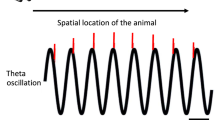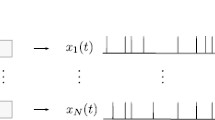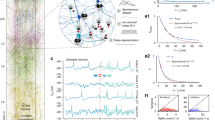Abstract
Temporal precision of spiking response in cortical neurons has been a subject of intense debate. Using a canonical model of spike generation, we explore the conditions for precise and reliable spike timing in the presence of Gaussian white noise. In agreement with previous results we find that constant stimuli lead to imprecise timing, while aperiodic stimuli yield precise spike timing. Under constant stimulus the neuron is a noise perturbed oscillator, the spike times follow renewal statistics and are imprecise. Under an aperiodic stimulus sequence, the neuron acts as a threshold element; the firing times are precisely determined by the dynamics of the stimulus. We further study the dependence of spike-time precision on the input stimulus frequency and find a non-linear tuning whose width can be related to the locking modes of the neuron. We conclude that viewing the neuron as a non-linear oscillator is the key for understanding spike-time precision.
Similar content being viewed by others
References
Adrian ED, Zotterman Y (1926) The impulses produced by sensory nerve endings. Part. 2. The response of a single end organ. J. Physiol. 61: 151-171.
Azouz R, Gray CM (1999) Cellular mechanisms contributing to response variability of cortical neurons in vivo. J. Neuroscience 19: 2209-2223.
Azouz R, Gray CM (2000) Dynamic spike threshold reveals a mechanism for synaptic coincidence detection in cortical neurons in vivo. Proc. Natl. Acad. Sci. USA 97: 8110-8115.
Bair W, Koch C (1996) Temporal precision of spike trains in extrastriate cortex of the behaving macaque monkey. Neural Comp. 8: 1185-1202.
Barlow H (1994) The neuron doctrine in perception. In: M Gazzaniga, ed. The Cognitive Neuroscience. MIT Press, Boston. pp. 415-435.
Bialek W, Rieke F (1992) Reliability and information transmission in spiking neurons. Trends. Neurosci. 15: 428-434.
Bishop PO, Levick WR, Williams WO (1964) Statistical analysis of the dark discharge of lateral geniculate neurones. J. Physiol. 170: 598-612.
Britten KH, Shadlen MN, Newsome WT, Movshon JA (1993) Response of neurons in macaque MT to stochastic motion signals. Visual Neurosci. 10: 1157-1169.
Brunel N, Chance FS, Fourcard N, Abbott LF (2001) Effects of synaptic noise and filtering on the frequency response of spiking neurons. Phys. Rev. Lett. 86: 2186-2189.
Bryant HL, Segundo JP (1976) Spike initiation by transmembrane current: A white-noise analysis. J. Physiol. 260: 279-314.
Bugmann G, Christodoulou C, Taylor JG (1997) Role of temporal integration and fluctuation detection in the highly irregular firing of a leaky integrator neuron model with partial reset. Neural Comp. 9: 985-1000.
Calvin WH, Stevens CF (1968) Synaptic noise and other sources of randomness in motoneuron interspike intervals. J. Neurophysiol. 31: 574-587.
Connors BW, Gutnick MJ (1990) Intrinsic firing patterns of diverse neocortical neurons. Trends. Neurosci. 13: 99-104.
Coombes S, Bressloff P (1999) Mode locking and Arnold tongues in integrate-and-fire neural oscillators. Phys. Rev. E 60: 2086-2096.
Cox DR (1970) Analysis of Binary Data. Chapman and Hall, London.
de Charms RC, Zador A (2000) Neural representation and the cortical code. Annu. Rev. Neurosci. 23: 613-647.
de Ruyter van Steveninck RR, Strong SP, Koberle R, Bialek W (1997) Reproducibility and variability in neural spike trains. Science 275: 1805-1808.
Destexhe A, Paré D (1999) Impact of network activity on the integrative properties of neocortical pyramidal neurons in vivo. J. Neurophysiol. 81: 1531-1547.
Destexhe A, Rudolph M, Fellous J-M, Sejnowski TJ (2001) Fluctuating synaptic conductances recreate in vivo-like activity in neocortical neurons. Neurosci. 107: 13-24.
Engel AK, König P, Kreiter AK, Schillen TB, Singer W (1992) Temporal coding in the visual cortex: New vistas on integration in the nervous system. Trends Neurosci. 15: 218-226.
Ermentrout GB, Kopell NK (1984) Frequency plateaus in a chain of weakly coupled oscillators I. SIAM J. Math. Analysis 15: 215-237.
Ermentrout GB, Kopell NK (1986) Parabolic bursting in an excitable system coupled with a slow oscillation. SIAM J. Appl. Math. 46: 233-253.
Ermentrout GB, Pascal M, Gutkin B (2001) The effects of spike frequency adaptation and negative feedback on the synchronization of neural oscillators. Neural Comp. 13: 1285-1310.
Fellous J-M, Howeling AR, Modi RH, Rao RPN, Tiesinga PHE, Sejnowski T J (2000) Frequency dependence of spike timing reliability in cortical pyramidal cells and interneurons. J. Neurophys. 85: 1782-1787.
Gray CM (2000) Synchronous oscillations in neuronal systems: Mechanisms and functions. J. Comp. Neurosci. 1: 11-38.
Gutkin BS, Ermentrout GB (1998) Dynamics of membrane excitability determine interspike interval variability: A link between spike generation mechanisms and cortical spike train statistics. Neural Comp. 10: 1047-1065.
Gutkin BS, Laing C, Colby C, Chow CC, Ermentrout GB (2001) Turning on and off with excitation: The role of spike-timing synchrony and asynchrony in sustained neural activity. J. Comp. Neurosci. 11: 121-134.
Hansel D, Mato G, Meunier C (1995) Synchrony in excitatory neural networks. Neural Comp. 7: 307-337.
Harsch A, Robinson HPC (2000) Postsynaptic variability of firing in rat cortical neurons: The role of input synchronization and synaptic NMDA receptor conductance. J. Neurosci. 20: 6181-6192.
Hodgkin AL (1948) The local changes associated with repetitive action in non-medulated axon. J. Physiol. 107: 165-181.
Hoppensteadt F, Izhikevich E (1997) Weakly Connected Neural Nets. Springer-Verlag, Berlin.
Howeling AR, Modi RH, Granter P, Fellous J-M, Sejnowski TJ (2001) Models of frequency preferences of prefrontal cortical neurons. Neurocomputing 38: 231-238.
Hunter JD, Milton JG, Thomas PJ, Cowan JD (1998) Resonance effect for neural spike time reliability. J. Neurophysiol. 80: 1427-1438.
Jensen R, Jones L, Gartner DH (1998) Synchronization of randomly driven nonlinear oscillators and the reliable firing of cortical neurons. In: JM Bower, ed. Computational Neuroscience: Trends in Research 1998. New York: Plenum.
Kretzberg J, Egelhaaf M, Warzecha AK (2001) Membrane potential fluctuations determine the precision of spike timing and asynchronous activity: A model study. J. Comp. Neurosci. 10: 79-97.
Krüger J, Becker JD (1991) Recognizing the visual stimulus from neuronal discharges. Trends Neurosci. 14: 282-286.
Latham PE, Richmond BJ, Nelson PG, Nirenberg S (2000) Intrinsic dynamics in neuronal networks. I. Theory. J. Neurophysiol. 83: 808-827.
MacKay D, McCulloch W (1952) The limiting information capacity of a neuronal link. Bull. Math. Biophys. 14: 127-135.
Mainen ZF, Sejnowski T J (1995) Reliability of spike timing in neocortical neurons. Science 268: 1503-1506.
McClurkin JW, Optican LM, Richmond BJ, Gawne TJ (1991) Concurrent processing and complexity of temporally encoded neuronal messages in visual perception. Science 253: 675-677.
McCormick DA, Connors BW, Lighthall JW, Prince DA (1985) Comparative electrophysiology of pyramidal and sparsely spiny stellate neurons of the neocortex. J. Neurophysiol. 54: 782-806.
Needleman DJ, Tisienga PHE, Sejnowski TJ (2001) Collective enhancement of precision in networks of coupled oscillators. Physica D 155: 324-336.
Nowak LG, Sanchaez-Vives MV, McCormick DA (1997) Influence of low and high frequency inputs on spike timing in visual cortical neurons. Cerebral Cortex 7: 487-501.
Panzeri S, Petersen RS, Schultz SR, Lebedev M, Diamond ME (2001) The role of spike timing in the coding of stimulus location in rat somatosensory cortex. Neuron 29: 769-777.
Paré D, Shrink E, Gaudreau H, Destexhe A, Lang EJ (1998) Impact of spontaneous synaptic activity on the resting properties of cat neocortical pyramidal neurons in vivo. J. Neurophysiol. 79: 1450-1460.
Prut Y, Vaadia E, Bergman H, Haalman I, Slovin H, Abeles M (1998) Spatiotemporal structure of cortical activity: Properties and behavioral relevance. J. Neurophysiol. 79: 2857-2874.
Reinagel P, Reid RC (2000) Temporal coding of visual information in the thalamus. J Neurosci. 20: 5392-5400.
Rinzel JM, Ermentrout GB (1998) Analysis of Neuronal Excitability, in Methods in Neuronal Modeling, 2nd edn. C Koch, I Segev, eds. MIT Press Cambridge, MA.
Rudolph M, Destexhe A (2002) Gain modulation and frequency locking under conductance noise. CNS 2002 Abstract.
Salinas E, Sejnowski TJ (2000) Impact of correlated synaptic input on output firing rate and variability in simple neuronal models. J. Neurosci. 20: 6193-6209.
Shadlen M, Newsome WT (1998) The variable discharge of cortical neurons: Implications for connectivity, computation, and information coding. J. Neurosci. 18: 3870-3896.
Stafstrom CE, Schwindt PC, Crill WE (1984) Repetitive fring in layer V neurons from cat neocortex in vitro. J. Neurophysiol. 52: 264-277.
Tang A (1997) Effects of cholinergic modulation on responses of neocortical neurons to fluctuating input. Cereb. Cortex 7: 502-509.
Teich MC, Henegan C, Lowen SB, Ozaki T, Kaplan E (1997) Fractal character of the neural spike train in the visual system of the cat. J. Opt. Soc. Am. 14: 529-546.
Theunissen F, Miller JP (1995) Temporal encoding in nervous systems: A rigorous definition. J. Comp. Neurosci. 2: 149-162.
Thorpe S, Fize D, Marlot C (1996) Speed of processing in the human visual system. Nature 381: 520-522.
Tovée MJ, Rolls ET, Treves A, Bellis RP (1993) Information encoding and the responses of single neurons in the primate temporal visual cortex. J. Neurophysiol. 70: 640-654.
Van Rossum MCW (2001) The transient precision of integrate and fire neurons: Effects of background activity and noise. J. Comp. Neurosci. 10: 303-311.
Wang X-J (1998) Calcium coding and adaptive temporal computation in cortical pyramidal neurons. J. Neurophysiol. 79: 1549-1566.
Author information
Authors and Affiliations
Rights and permissions
About this article
Cite this article
Gutkin, B., Ermentrout, G.B. & Rudolph, M. Spike Generating Dynamics and the Conditions for Spike-Time Precision in Cortical Neurons. J Comput Neurosci 15, 91–103 (2003). https://doi.org/10.1023/A:1024426903582
Issue Date:
DOI: https://doi.org/10.1023/A:1024426903582




